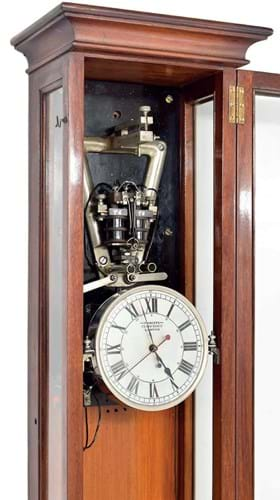“There are few books on the subject and, as yet, not many collectors,” said auctioneer Jamie South, who had two examples from the inter-war years at Gardiner Houlgate’s (20% buyer’s premium) specialist horology sale at Corsham on October 25.
“However, what collectors there are, are knowledgeable and enthusiastic and they all seemed to turn out for the sale of the first tranche of the Arthur Mitchell collection,” said South.
Lifelong collector
Mitchell, a lifelong collector, was founding member of the Electrical Horology Group in 1970 – a sub group of the Antiquarian Horology Society– where he served as secretary for 25 years until 1995.
His collection included two electrical master clocks produced by Princeps, the firm set up by Major CE Prince, who had been officer-in-charge of the fledgling RAF’s Experimental Wireless Section and a member of the Marconi Company’s research staff.
The benefits of his patented yeargoing clocks driven by a battery were outlined in his promotional pamphlet.
They were more accurate than spring-driven clocks or other electrical ones and one ‘master’ ensured every other ‘slave’ told the same time. Prince pointed out that this saved paying “the numerous commercial undertakings all over the world who are running profitable businesses synchronising public clocks and the like”.
One, in a 5ft 7in (1.75m) long glazed mahogany case, signed to the 5in (12.5cm) silvered dial Princeps, 173, New Bond St, London, Patent applied for, sold at £8800.
The other, a little later, signed Princeps, New System, 1, Arundel St. WC2, in a 4ft 10in (1.47m) oak glazed case, made £3000.
Both went to collectors at sums way above £500-800 estimates.
Familiar face
Mitchell, who was in his eighties when he died earlier this year, was a regular face at GH’s horology sales and always generous in sharing his expertise, but aspects of electrical clocks still need research. “Some of the items in the second part of the collection being sold in February still baffle experts,” said South.
Three centuries before Major Prince’s work, the eminent Warminster clockmaker Edward Cockey (1669-1768) was producing pioneering timepieces for royalty and the aristocracy.
His rare, early 18th century musical clock offered at the GH auction was signed to the 12in (30cm) square brass dial but was a ‘marriage’ (using a later case, not an original) in a 6ft 11in (2.11m) oak case.
Furthermore, the movement striking on a nest of eight bells was rusted up.
In almost any other field, the need for such comprehensive restoration would usually mean the buyer was a dealer but the horology world is full of knowledgeable, practical collectors who happily take up the work. It was a private buy at £5200.















